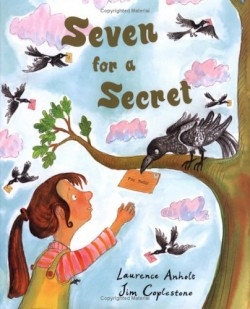Seven for a Secret
Everyone has secrets. Some secrets are happy, like the one Grandpa has for Ruby. She’s going to be a big sister, and Grandpa has “been hiding shiny things” that he plans to pass on to her. Other secrets are sad, such as Dad’s fear that they will lose their home and not be able to afford the new baby. But Grandpa has the saddest secret of all: he’s dying and may never see Ruby again or get to meet her baby brother. Originally published in England, this book introduces the legend of “The Magpie Song,” which goes: “1 for Sorrow, 2 for Joy, 3 for a Girl, 4 for a Boy…”
The author is a notable author and illustrator, with more than seventy titles (some of them written with his wife, Catherine Anholt) to his credit. He wrote and illustrated a series of books about artists, featuring such titles as Camille and the Sunflowers: A Story about Vincent van Gogh and Picasso and the Girl with a Ponytail: a Story about Pablo Picasso. He has received numerous awards, including the Nestlé Smarties Gold Award and the Sheffield Children’s Book Award. He now lives in Lyme Regis, South West England. The illustrator also lives in England, where he has taught primary school. He provided art for Noah’s Bed, written by his wife Lis Coplestone.
Young readers may come to the end of the story unaware of the symbolism of the single magpie that arrives at Ruby’s home in the city, but those who focus on the illustrations will have a clue. The cartoon illustrations extend the story, revealing what the words do not. The large four-page spread that unfolds and extends beyond the width of the book reveals the “top secret” hidden underneath a lift-the-flap in one of Grandpa’s letters.
The endpages at the front of the book represent the urban setting that introduces the reader to Ruby’s life in the city, where “It’s noisy” and she hears “police cars, a dog barking and the TV next door” and sees “a million orange lights below.” In contrast, the endpages at the back of the book offer a serene depiction of the country, where Ruby and her family have discovered the meaning of the “2 for Joy” in the magpie song.
Told completely in letters between two different generations, reminiscent of Soyung Pak’s Dear Juno, this book offers contrasts—young/old, city/country, life/death—that might spark insightful conversations with young readers eager to maintain relationships with family members near and far.
Reviewed by
Kaavonia Hinton
Disclosure: This article is not an endorsement, but a review. The publisher of this book provided free copies of the book to have their book reviewed by a professional reviewer. No fee was paid by the publisher for this review. Foreword Reviews only recommends books that we love. Foreword Magazine, Inc. is disclosing this in accordance with the Federal Trade Commission’s 16 CFR, Part 255.

